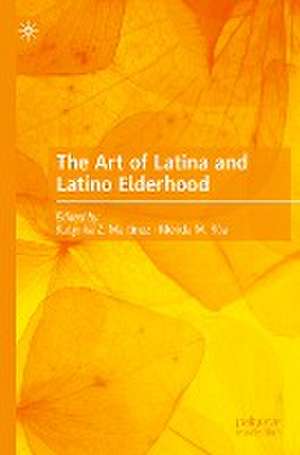The Art of Latina and Latino Elderhood
Editat de Katynka Z. Martínez, Mérida M. Rúaen Limba Engleză Paperback – 21 noi 2023
Previously published in Latino Studies Volume 19, issue 4, December 2021
| Toate formatele și edițiile | Preț | Express |
|---|---|---|
| Paperback (1) | 689.64 lei 6-8 săpt. | |
| Springer Nature Switzerland – 21 noi 2023 | 689.64 lei 6-8 săpt. | |
| Hardback (1) | 695.70 lei 6-8 săpt. | |
| Springer Nature Switzerland – 21 noi 2022 | 695.70 lei 6-8 săpt. |
Preț: 689.64 lei
Preț vechi: 811.34 lei
-15% Nou
Puncte Express: 1034
Preț estimativ în valută:
131.96€ • 137.79$ • 108.97£
131.96€ • 137.79$ • 108.97£
Carte tipărită la comandă
Livrare economică 15-29 aprilie
Preluare comenzi: 021 569.72.76
Specificații
ISBN-13: 9783031190100
ISBN-10: 3031190106
Pagini: 139
Ilustrații: VI, 139 p.
Dimensiuni: 155 x 235 mm
Greutate: 0.22 kg
Ediția:1st ed. 2022
Editura: Springer Nature Switzerland
Colecția Palgrave Macmillan
Locul publicării:Cham, Switzerland
ISBN-10: 3031190106
Pagini: 139
Ilustrații: VI, 139 p.
Dimensiuni: 155 x 235 mm
Greutate: 0.22 kg
Ediția:1st ed. 2022
Editura: Springer Nature Switzerland
Colecția Palgrave Macmillan
Locul publicării:Cham, Switzerland
Cuprins
The art of Latina and Latino elderhood: A note from the editor.- Special issue: The art of Latina and Latino elderhood.- Reflections of an aging Chicano boomer: Growing old in the time of demographic transformation.- Operation Granma G.- Dancing among older Latinos: Interweaving health and culture.- Hairpiece: A photo essay featuring Yolanda Lopez.- In your fifties, you’re like the crone, sixties, and you are the abuela: A diálogo with older Latina actors.- The abuela perplex: Unscripting Latina elderhood.- Vital minimums: El Salvador between youth and old age.- A lesson learned: The beginning and end of life.
Notă biografică
Katynka Z. Martínez is Professor and Department Chair of Latina/Latino Studies at San Francisco State University, USA.
Mérida M. Rúa is Professor in the Latina and Latino Studies Program at Northwestern University, USA.
Mérida M. Rúa is Professor in the Latina and Latino Studies Program at Northwestern University, USA.
Textul de pe ultima copertă
It is widely recognized that Latinos are a sizable and diverse population and that they are a young demographic. The median age of non-Hispanic white Americans is 58, whereas for Latinos it is 30. Perhaps this partially explains the dearth of attention afforded to the topic of aging Latinos by academic scholarship and the mainstream media. This book compellingly alerts us to the reality that there is a growing, aging Latino population about which we know very little and that deserves our attention. The book responds to this significant gap in our knowledge with an exciting set of academic articles and creative contributions that challenges not only our assumptions about Latinos and aging but also our thinking on the types of contributions in an academic context. The contributors make the case that the story of Latino elderhood is best conveyed through a truly multidisciplinary and interdisciplinary approach, bringing together public policy, humanistic social sciences, and artistic interventions.
Previously published as a Special Issue in the journal: Latino Studies "Special Issue: The Art of Latina and Latino Elderhood"
